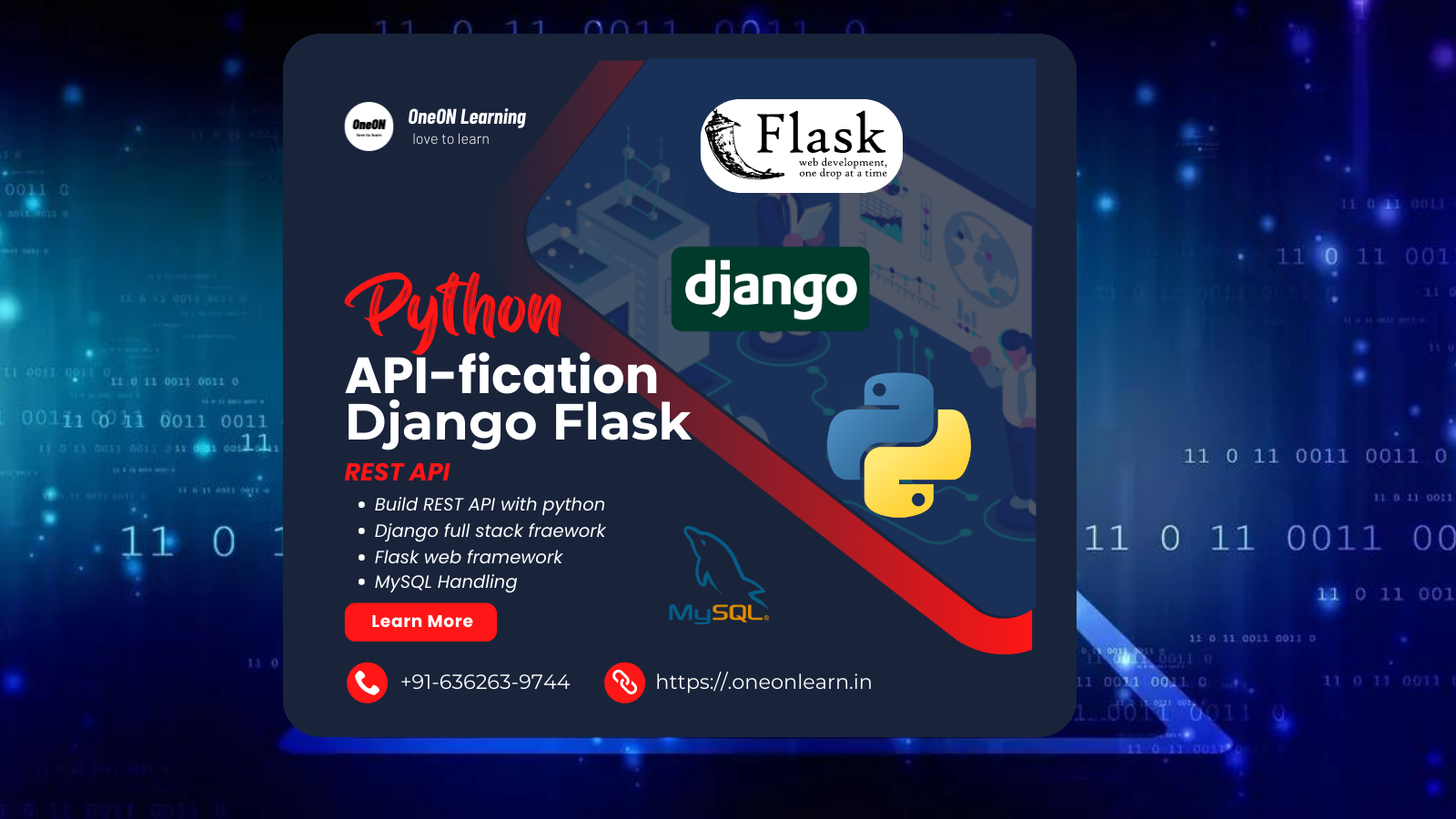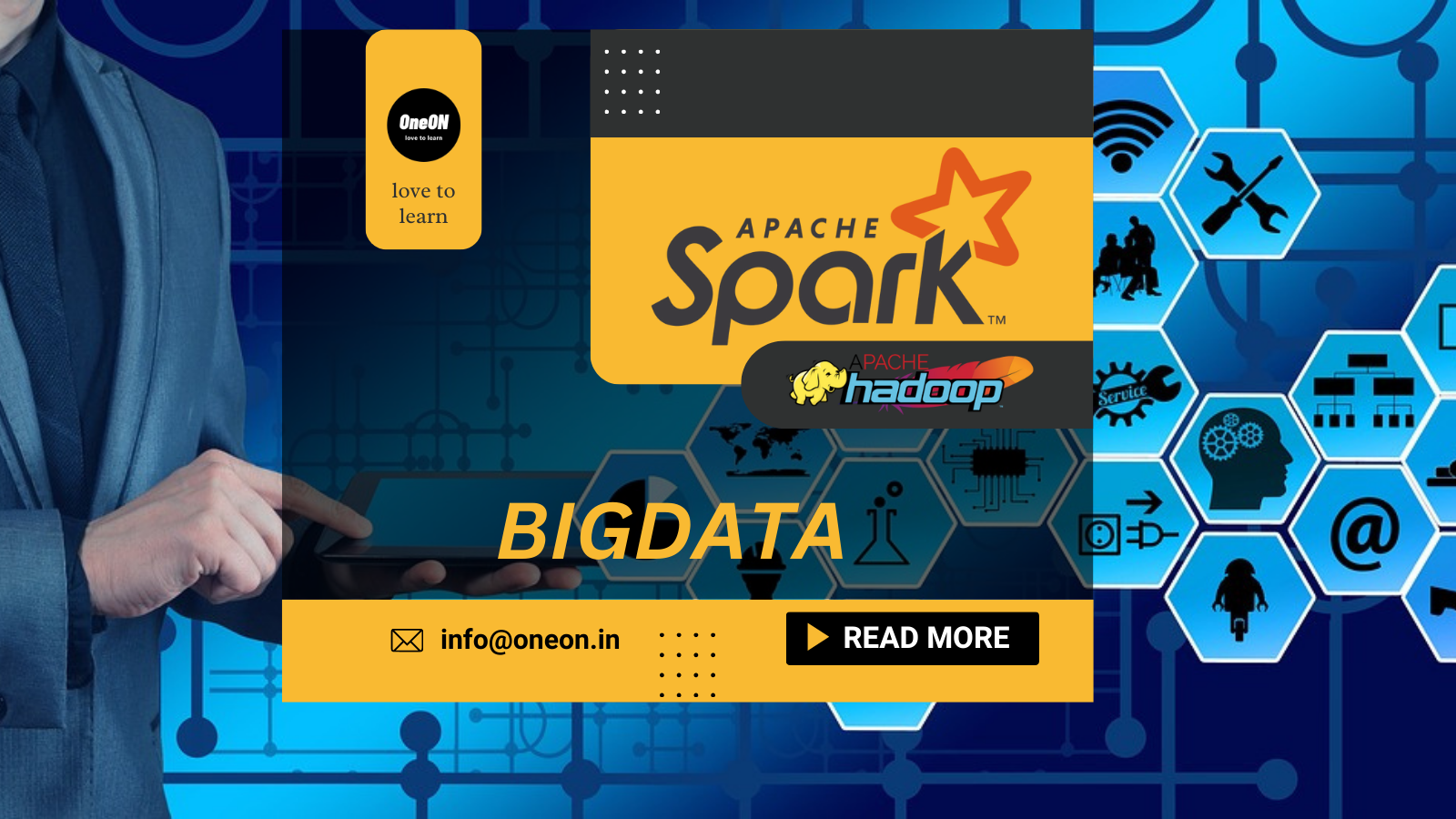OneON Learning
Site blog

Python RESTful API
RESTful API is an architectural style for building web services that are easy to maintain and scalable. Python provides several libraries for working with RESTful APIs, including Flask and Django123.
Python RESTful API MySQL handling
To handle MySQL database in Python RESTful API, you can use Flask and MySQL modules. Flask is a web framework while MySQL module is required to establish a connection with the MySQL database and query the database using Python programming language12.
Python provides several libraries for working with MySQL databases. One of the most popular libraries is the MySQL Connector library, which allows you to connect to a MySQL database and execute SQL queries using Python12.
Django framework
Django is a high-level Python web framework that enables rapid development of secure and maintainable websites. It was built by experienced developers and takes care of much of the hassle of web development, so you can focus on writing your app without needing to reinvent the wheel. It is free and open source123.
Django vs Flask vs Ruby on Rails
Django and Flask are both Python web frameworks. Django is a high-level framework that includes an ORM (Object-Relational Mapping) and follows the Model-View-Template (MVT) architectural pattern. It is designed for rapid development and includes many built-in features12. Flask is a micro-framework that is more flexible and lightweight than Django. It follows the Model-View-Controller (MVC) architectural pattern3.
Ruby on Rails is another popular web framework that is written in Ruby. It follows the Model-View-Controller (MVC) architectural pattern and is designed for rapid development4.
In terms of popularity, Django is more popular than Flask and Ruby on Rails5. However, each framework has its own strengths and weaknesses. Django is great for building complex web applications quickly, while Flask is more suited for smaller projects that require more flexibility. Ruby on Rails is also great for rapid development and has a large community of developers145.
Popular websites built with Django
Some popular websites built with Django include Disqus, PADI Travel, Instagram, The Washington Post, The Guardian, NASA website and many more1234.
Flask is a micro web framework written in Python. It is classified as a microframework because it does not require particular tools or libraries. It has no database abstraction layer, form validation, or any other components where pre-existing third-party libraries provide common functions12.
Advantages of using Flask
Flask is a web framework for Python that provides tools, libraries, and technologies to build web applications
. Here are some advantages of Flask:- Scalable: Flask's status as a microframework means that it can be used to grow a tech project such as a web app incredibly quickly. Its simplicity of use and few dependencies enable it to run smoothly even as it scales up and up
- Flexible: Flask provides developers with plenty of room for flexibility regarding design and website architecture. Flask grants developers absolute control over what features are implemented into their websites as the framework does not enforce any fixed layouts, applications, or tools.
- Easy to understand: Flask is simple enough to get started with, which makes it an excellent framework for beginners. Its simplicity gives developers the opportunity to understand it better and learn from it. There are interesting features to use in the framework. The simplicity in the Flask framework enables the developer to navigate around and create the application easily.
- Lightweight: Flask is a lightweight framework that offers hassle-free development. It is easy to negotiate and has few dependencies, making it easy to install and use
- Good documentation: Flask has good documentation that is arranged in a structured manner. This encourages developers to use the framework, as they can easily get introduced to the different aspects and capabilities of the tool.
Some popular websites built with Flask include Reddit, Netflix, Airbnb, Lyft and Patreon1234.

Spring Boot Overview:
Spring Boot is an open-source Java-based framework used for creating standalone, production-grade Spring-based applications with minimal configuration. It is designed to simplify the development process and make it easier to create microservices and web applications.
Here are some key features and concepts of Spring Boot:
Auto-configuration: Spring Boot provides automatic configuration for various dependencies and frameworks based on the project's classpath. It eliminates the need for manual configuration and reduces boilerplate code.
Embedded server: Spring Boot includes an embedded servlet container, such as Tomcat, Jetty, or Undertow. It allows you to run your application as a standalone JAR file without the need for deploying it to a separate server.
Starter dependencies: Spring Boot offers a wide range of starter dependencies that provide pre-configured dependencies for different use cases, such as web applications, databases, security, messaging, etc. These starters simplify the management of dependencies and their versions.
Actuator: Spring Boot Actuator provides production-ready features to monitor and manage your application. It exposes various endpoints that allow you to gather information about your application's health, metrics, configuration, and more.
Spring Boot CLI: Spring Boot Command-Line Interface is a tool that allows you to quickly develop Spring Boot applications using Groovy syntax. It helps in rapid prototyping and simplifies the setup process.
Spring Data JPA: Spring Boot integrates with Spring Data JPA, which provides a convenient way to perform database operations using Java Persistence API (JPA). It simplifies database access and reduces the amount of boilerplate code needed.
Spring Security: Spring Boot offers integration with Spring Security, a powerful and highly customizable security framework. It provides authentication, authorization, and other security features out of the box, making it easier to secure your applications.
Here are some links that can help you get started:
- Building a Spring Boot REST API - Better Programming
- Spring Boot REST API Using JPA, Hibernate, MySQL Tutorial
- Spring Boot 3, MySQL, Spring Data JPA, Hibernate CRUD REST API Tutorial …
Rest API Overview:
A REST API (Representational State Transfer Application Programming Interface) is a set of rules and conventions that allow different software applications to communicate and interact with each other over the internet. It is based on the principles of the REST architectural style.
Here are some key concepts and characteristics of a REST API:
Resources: In a REST API, resources are the key entities that the API exposes. Resources can be any information or object that needs to be accessed or manipulated. For example, in a social media application, resources could be users, posts, comments, or photos.
HTTP Methods: REST APIs use HTTP methods to perform different actions on resources. The most commonly used HTTP methods in REST are:
- GET: Retrieve a resource or collection of resources.
- POST: Create a new resource.
- PUT: Update an existing resource.
- DELETE: Remove a resource.
URLs/URIs: Each resource in a REST API is identified by a unique URL (Uniform Resource Locator) or URI (Uniform Resource Identifier). The URL represents the address or endpoint where the resource can be accessed.
Stateless: REST APIs are stateless, meaning that each request from a client to the server should contain all the necessary information to process the request. The server does not store any information about the client's previous requests.
Representation of Resources: Resources in a REST API are represented in a specific format, such as JSON (JavaScript Object Notation) or XML (eXtensible Markup Language). JSON is the most widely used format due to its simplicity and compatibility with various programming languages.
Hypermedia (HATEOAS): Hypermedia as the Engine of Application State (HATEOAS) is a principle of REST APIs that allows clients to discover and navigate available resources dynamically through the API responses. In simpler terms, the API response provides links or URLs to related resources, enabling clients to explore the API's capabilities.
Authentication and Authorization: REST APIs often include mechanisms for authentication and authorization to ensure secure access to protected resources. Common authentication methods include API keys, tokens (such as JWT), or OAuth.
Developers can create REST APIs using various programming languages and frameworks. Popular choices for building REST APIs include Node.js with Express, Python with Django or Flask, Ruby with Ruby on Rails, and Java with Spring Boot.
REST APIs have become a standard approach for building web services due to their simplicity, scalability, and compatibility with different platforms and technologies. They are widely used in web and mobile applications to enable communication between client applications and server-side resources.
JPA Overview:
Learn More:
1. betterprogramming.pub 2. javatodev.com 3. javaguides.net 4. freecodecamp.org 5. javaguides.net 6. twilio.com

Hadoop and Spark popular Big Data Processing Framework
Hadoop and Spark are two of the most popular big data processing frameworks used in the industry. Hadoop is most effective for scenarios that involve processing big data sets in environments where data size exceeds available memory. It reads and writes files to HDFS1. Spark is a fast and general processing engine compatible with Hadoop data. It can run in Hadoop clusters through YARN or Spark’s standalone mode, and it can process data in HDFS, HBase, Cassandra, Hive, and any Hadoop InputFormat2.
Here are some key differences between the two:
- Spark outperforms Hadoop by providing additional use cases such as the analysis of real-time stream data, handling sets of parallel operations using several iterative algorithms and graph-parallel processing for modelling the data3.
- Hadoop reads and writes files to HDFS while Spark processes data in RAM using a concept known as an RDD (Resilient Distributed Dataset)4.
There are several big data processing frameworks available in the industry. Here are some of the most popular ones:
- Hadoop: This open-source batch-processing framework can be used for the distributed storage and processing of big data sets1.
- Apache Spark: This is a batch-processing framework with the capability of stream processing and making it a hybrid framework1.
- Apache Storm: This is another open-source framework that provides distributed, real-time stream processing2.
- Samza: This is a distributed stream processing framework that provides fault tolerance, local state management, and scalability2.
- Flink: This is an open-source stream processing framework that provides low-latency and high-throughput data processing1.
Batch processing is a technique used in big data processing where a large amount of data is collected and processed at once. It is used for processing large volumes of data that do not require real-time processing. Batch processing is typically used for tasks such as generating reports, aggregating data, and preparing data for further analysis.
What is Real-time processing ?
Real-time processing is a method of processing data at a near-instant rate, requiring a constant flow of data intake and output to maintain real-time insights1. Real-time processing deals with streams of data that are captured in real-time and processed with minimal latency to generate real-time (or near-real-time) reports or automated responses2. For example, a real-time traffic monitoring solution might use sensor data to detect high traffic volumes2.
What is Data Stream ?
A data stream is a sequence of data elements made available over time1. It is a continuous flow of data that is generated from various sources and can be processed in real-time2. For example, a data stream can be generated from sensors that are monitoring temperature or humidity levels2.
Learn More:
1. ibm.com 2. spark.apache.org 3. codingninjas.com 4. geeksforgeeks.org 5. ibm.com 6. integrate.io 7. hadoop.apache.org
1. knowledgehut.com 2. papers.ssrn.com 3. techreviewer.co
1. hpe.com 2. learn.microsoft.com 3. techopedia.com 4. hevodata.com
1. geeksforgeeks.org 2.confluent.io 3. cloud.google.com 4. cloud.google.com 5. snowflake.com